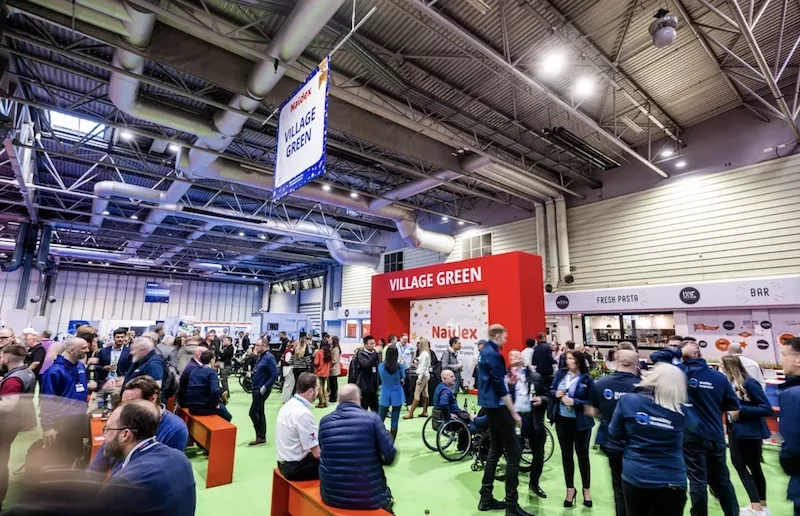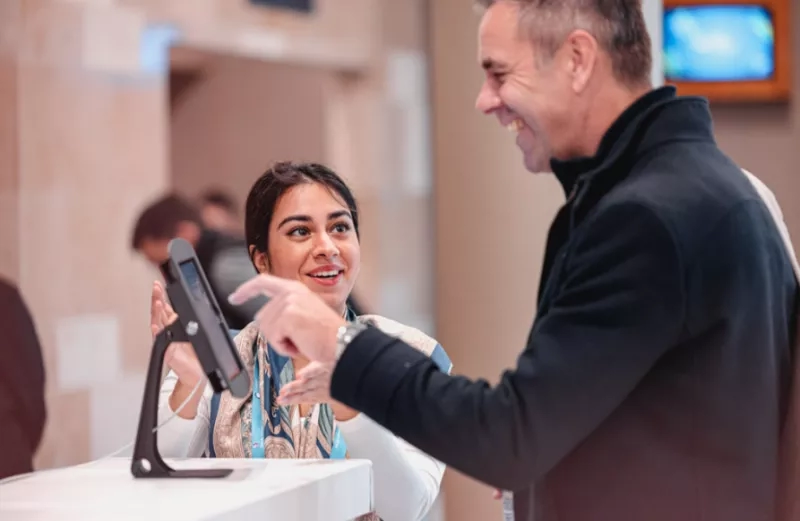Accessibility and inclusion have always been core values, but they are also vital for business success.
Accessible events signal that your organization values all people. This builds brand trust, strengthens reputation, and demonstrates social responsibility, which matters to attendees, sponsors, and partners alike.
Whether you stage small meetings or large conferences, careful consideration of accessibility, both online and in-person, will ensure that all your attendees have a positive and inclusive experience.
Besides, the regulatory landscape is moving in only one direction, towards stricter inclusion requirements such as WCAG 3.0 and the new European Accessibility Act.Prioritizing accessibility now will help you stay ahead of legal and market shifts.
Read on to learn practical tips and best practices you can implement to ensure accessibility is at the heart of your event planning - before, during and after your event.
Why event accessibility matters
Some 16% of people worldwide have a disability according to the World Health Organization (WHO).
Across Europe, the average is higher. In 2023, 27% of the EU population (or 101 million people) over the age of 16 had some form of disability. In the UK, it’s almost 22% of the population (or 14.1 million people). In the US, it’s over 28% (or one in four adults).
The WHO says these numbers are increasing, due in part to ageing populations and a rise in neurodivergency diagnoses.
If your events aren’t accessible, you’re likely missing the chance to engage a much wider audience, including the spending power of individuals with disabilities (known as the purple pound), entire households, or even friendship groups in which at least one member has additional needs.
Put simply, creating an accessible event means designing it for everyone, regardless of disability, from the moment someone visits your website to when they leave your venue.
You’re also legally obligated to make your events fully accessible. In the UK, disability is one of nine ‘protected characteristics’ defined by the 2010 Equality Act, making it illegal for any business to discriminate against persons with disabilities (or PWDs). In the US, there is the Americans with Disabilities Act (ADA), which protects people with disabilities from discrimination.
Introducing the European Accessibility Act
If you operate within the European Union, attract EU-based attendees to your events, employ more than 10 people and have a turnover greater than €2 million, you will need to comply with the European Accessibility Act (EAA), which came into force on 28 June 2025.
The legislation applies to any business offering event websites, ticket sales, apps or other digital event services to residents of EU countries, regardless of where your business is based. Any new online product must comply straight away. For existing products and services, organisations have until 28 June 2030 to become fully compliant.
The EAA states that websites and mobile apps must comply with the current version of the Web Content Accessibility Guidelines(WCAG 2.2).
These WCAG guidelines are organized into four principles (POUR):
- Perceivable: Information should be presented in ways that all users can access, such as providing alternative text for images.
- Operable: Interfaces should be easy to navigate when using a variety of devices and assistive technologies.
- Understandable: Content should be clear and predictable.
- Robust: Websites and digital tools should work with a wide range of assistive technologies.
💡 Want to know more? Read How the European Accessibility Act Will Impact Your Events
Understanding accessibility needs
Accessibility needs can be divided into physical and non-visible disabilities. Physical disabilities refer to impairments affecting a person’s mobility, vision, or hearing, while non-visible disabilities refer to those that aren’t immediately apparent, such as neurodivergent states and mental health conditions.
Here are some examples to consider when planning for your event.
Mobility impairments
Visitors with restricted movement may use wheelchairs or mobility scooters. For them to get around your event comfortably and safely, accessibility solutions like ramps, lifts, wider aisles and allocated parking spaces should be provided.
Visual impairments
For the visually impaired, you should consider accessible solutions such as braille signage and audio description. Large print options also provide an additional layer of support so that everyone has equal access to information.
Hearing impairments
For those visitors who may struggle to hear and understand on-stage presentations, you’ll need to consider using sign language interpreters, captioning services, and audio amplification devices.
Cognitive disabilities
Visitors with cognitive disabilities may face difficulty understanding or interpreting information and sensory stimuli.
To make your content and design accessible for them, you should keep text-based language (e.g. signage, flyers and agendas) simple, and provide visual cues and sensory-friendly spaces.
Something as commonplace as color blindness can have a significant impact on a person’s decision whether to go to an event. So remember to keep visual design elements simple and never color-code your event features or agenda.
Neurodivergent conditions
Autism, ADHD, dyslexia and other neurodivergent conditions have a significant impact on a person’s ability to engage with traditional event design, such as crowded, noisy theatres or interactive networking.
To cater for people with neurodivergence, you should provide sensory-friendly environments, quiet areas of respite when needed, and prior notice of changes to schedules or routines.
Mental health conditions
Mental health conditions, like depression, PTSD, and anxiety, can greatly impact a person’s emotional or psychological state. To support individuals with mental health difficulties during your event, you could offer accessible mental health resources and allow emotional support animals.
5 steps to planning accessible events
“Start planning your events from the beginning with accessibility in mind. You need to build in accessibility from the get-go. If you make your environments and products accessible and show that you are committed, it opens the door to more attendees, and word travels quickly. For us, it has been the marketing tool that you could use.”
Julia Santiago, Managing Director at Center on Disabilities (CSUN), speaking on Hot Take: What’s New and Trending in the World of Accessibility
Let’s now look at the various stages of event design to determine where accessible planning can come into play.
Registration
The registration page on your event website is the first opportunity to discover what additional needs your attendees may have. So, make sure the event platform used to design and host your site is accessible to all, and your registration asks the right questions with checkboxes.
These could include questions such as:
- Do you require captions?
- Do you require a sign language interpreter?
- Will you be accompanied by a service animal or a Personal Care Assistant (PCA)?
- Do you require wheelchair access?
By asking more detailed questions at the registration stage or by contacting anyone who has requested certain requirements, you’ll not only create a positive first impression of your event but also give yourself more planning time to incorporate additional accessible elements.
On-site experience
To improve the on-site experience, put yourself in the shoes of a disabled person and consider their entire attendee journey.
For example, to accommodate visitors using wheelchairs, consider widening the aisles or adding some lower poseur tables. Don’t forget to assign a dedicated wheelchair area in your conference hall or break-out rooms.
Other visitors with physical impairments may be accompanied by a care assistant, who is there to assist the attendee. You’ll need to ensure that:
- They’re given free entry
- They’re always able to sit next to the person they’re looking after
- You’ve factored them into catering numbers and room capacities
The same goes for service animals, such as a guide dog for a visually impaired attendee. You’ll need to ensure that:
- There’s a reserved space for them at the end of an aisle so that their dog can remain alongside
- You provide facilities such as drinking water and somewhere for a dog to go to the toilet
- Staff are made aware not to distract or fuss over a service animal
Quiet rooms and wellness spaces for anybody to take a break from the hustle and bustle of the show floor are a great addition to your event.
3. Virtual and hybrid events
Making your events accessible also extends to virtual and hybrid formats. Here are some tips:
- Ensure that online presentations meet certain color contrast ratios so that they’re accessible for the visually impaired or people with color blindness.
- Not everyone attending virtually will be able to see or interpret the presentation slides. So ask presenters to explain visual content.
- Attendees who have a hearing impairment may require online presentations to show more detail, offer live captions or have someone in the chat who can answer their questions in real-time.
4. Communication and information accessibility
Including accessibility information in the design of your pre-event communications is key.
- For instance, add a simple line at the base of posters or flyers written in black text on a light background that reads ‘Our theater is wheelchair accessible’ or ‘A sign language interpreter will be available.’
- Check if presentation fonts are large enough to be read from the back row of seats, images are of high quality, and messaging is clear.
- If you’re using a sign language interpreter, make sure that enough seats for visually impaired delegates are reserved in the front row. Having the correct lighting and background also ensures that the interpreter’s face and hands can be seen from the stage.
- If your event attracts a lot of attendees with additional needs, consider placing an “accessibility desk” by the entrance. Inform registered attendees that they may seek additional help from the desk attendant if they encounter any problems.
5. Staff training and awareness
Create a culture of inclusion by ensuring that everyone involved in the planning and execution of your event is given the same level of training.
For example, when an attendee arrives at your onsite registration desk, train staff to identify when a person needs additional time to respond or help with information, directions or the printing of their badge.
Your registration staff need to know the correct way to interact with a deaf attendee or a visually impaired person who arrives with a service animal, for example (e.g. don’t pet or fuss over the dog, don’t grab the attendee’s arm when giving directions).
Create a culture of inclusion by ensuring that everyone involved in the planning and execution of your event is given the same level of training.
Finding accessible venues and facilities
There are many ways your choice of venue can impact how easily different people can get involved in your event - from being able to move freely around the building, to feeling safe in an environment that won’t trigger a seizure or make them feel anxious or at risk.
When sourcing venues, consider both the accessibility within the venue and how your attendees may travel to your event.
Here are 10 venue-specific questions to reflect on:
- Can you reserve parking spaces for people who most need them?
- Is there ample space for mobility aids?
- Does the venue have an alternative accessible entrance? If so, will it remain unlocked during your event?
- Is the approach to the venue solid ground or will you need a temporary pathway? Soft mud and loose gravel can be problematic for many.
- Does the venue have step-free access throughout? Can lifts be accessed without having to ask for a key? Are the ramps of a gentle gradient (1:20), and do they have handrails on either side?
- What signage does the venue offer? Is the signage large and in high contrast? Embossed or in Braille? If not, can you put up your signs?
- Is there a loop system in your meeting room for hearing aid users? If so, is it working? Does anyone know how to switch it on or alter the volume? Will that person be there when you hold your event in the building?
- Does the venue offer ‘adapted’ toilets or gender-neutral toilets?
- Are there visual (flashing) fire alarms in private spaces like toilets, to alert deaf or hard-of-hearing delegates of a fire? If not, consider what you need to do in case of a fire alarm.
- 10. Is there a space available to use as a multi-faith prayer room?
💡Delve deeper with our Venue Accessibility Checklist: 17 Questions to Ask Your Venue
Using event and assistive technology
Use technology to improve the accessibility of your events. Here are two ways technology can keep you on the right track:
Accessible tools
Screen readers will convert text and other elements to speech or braille output for attendees with vision impairments or cognitive disorders.
If a site works with assistive technology, it mostly depends on the event platform, so please be sure to choose one that has been tested and verified to work with assistive technology, like screen readers.
To verify that an event platform meets accessibility standards, such as working with assistive technology, request a VPAT (Voluntary Product Accessibility Template) from the vendor. Cvent has VPATs for products such as our Event Registration, Attendee Hub, and others.
Ensure your event platform is compatible with third-party tools that allow audio content to be consumed in various languages for your global audiences.
Accessible design
When designing event or registration websites, use a platform like Cvent’s Attendee Hub, which lets you know when color combinations don’t meet accessibility guidelines to help you support attendees who may have visual impairments or be color vision deficient.
Add alternative text to images and make it easier for those using assistive technologies, such as screen readers and braille displays, to navigate your event website and registration process.
💡From screen readers to sign language interpretation, there’s a wealth of tools that can help ensure that all attendees have the same opportunity to participate and engage. Learn more about Cvent’s accessibility features.
Accessible events checklist
Before your event
- Invest the time and effort to find out what PWDs may need from you or your chosen venue.
- Everyone’s onsite experience should be equal so assess the content and layout of your event for accessibility, and ensure all staff are trained to provide customer support for all types of disabilities.
- Keep accessibility in mind when designing communications, online polls and feedback forms.
- Use technology to improve the accessibility of your website and virtual event elements, as well as the onsite experience for all.
During your event
- Work with your chosen venue to ensure that additional measures can be added and specific requests are supported.
After your event
- When your event is over, don’t forget to ask for, and act on, feedback from those attendees who had requested additional needs.
- Always acknowledge feedback and think carefully about what you can do differently to improve accessibility next time.
FAQs: Making events more accessible
1. What does accessibility mean in the context of events?
Accessibility refers to designing and delivering events so that everyone, regardless of ability, can participate fully. This includes physical access, communication access, digital access (like websites and apps), and inclusive content.
2. Why should accessibility be a priority for events?
Accessible events are more inclusive, reach wider audiences, and demonstrate social responsibility. They also reduce legal risk and often improve the overall experience for all attendees, not just those with disabilities.
3. How does the European Accessibility Act (EAA) impact event organizers?
The EAA, in effect from June 2025, requires that many products and services—especially digital ones like event platforms, ticketing, and websites—meet minimum accessibility standards across EU member states. Non-compliance could lead to legal and financial penalties.
4. Which parts of the event experience are covered by the EAA?
Under the EAA, areas like online ticket sales, mobile event apps, information terminals, and self-service kiosks must be accessible to people with disabilities. If your event uses digital systems in these areas, they need to comply.
5. Do the EAA rules apply to in-person events?
Yes, indirectly. While the EAA focuses on digital accessibility, many in-person event components (like wayfinding, registration kiosks, and information access) rely on digital tools that fall under the EAA. So it’s important to ensure that both digital and physical aspects align with accessibility requirements.
6. What other global legislation is there when it comes to accessibility in events?
In the United States, the Americans with Disabilities Act (ADA) requires that venues, websites, and event experiences be accessible to people with disabilities, and lawsuits for non-compliance have become increasingly common.
In Canada, the Accessible Canada Act (ACA) and the Accessibility for Ontarians with Disabilities Act (AODA) set out similar expectations, requiring proactive removal of barriers in public spaces and digital communications.
In the UK, disability is one of nine ‘protected characteristics’ defined by the2010EqualityAct
For virtual and hybrid events, many of these laws reference Web Content Accessibility Guidelines (WCAG) — the international standard for digital accessibility, which continues to evolve (with WCAG 3.0 on the horizon).
7. What are some quick wins for making a venue more accessible?
- Ensure step-free access to all main areas
- Provide accessible toilets with hoists
- Use clear signage and high-contrast visuals
- Offer reserved seating for attendees with mobility needs
- Train staff in disability awareness
8. How can I make my event communications more accessible?
Use plain language, provide captions or transcripts for video content, and ensure that websites and emails are screen-reader compatible. Use alt text for images and avoid relying on color alone to convey meaning.
9. What support can I offer to neurodivergent or autistic attendees?
Provide quiet zones, publish sensory-friendly schedules, and allow flexible arrival times. Familiarisation videos about the venue layout and what to expect can also be helpful.
10. Are there tools to test digital accessibility for events?
Yes. Tools like WAVE and Google Lighthouse can audit websites for WCAG compliance. You can also engage an accessibility consultant or tester with lived experience of disability for deeper insights.
11. What role can attendees play in helping events become more accessible?
Invite feedback before, during, and after the event. Include an accessibility section on your registration form where attendees can note specific requirements, and make sure those needs are addressed in advance.
Next steps
Accessibility in event planning is a must. With over a billion people, or 16% of the world’s population, experiencing some form of disability, making your events more accessible and inclusive is both a moral and legal obligation.
For a deeper understanding of accessibility and what it means for your event planning, check out the wealth of information available in our Accessibility Resource Hub.








